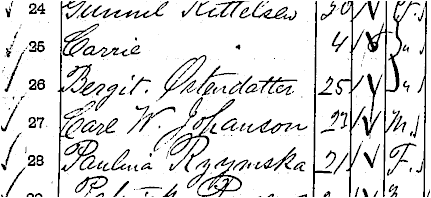Like most things in genealogy, illegibility is context dependent. We rarely have trouble reading a word that we expect to see. (That can be a problem in some cases if it leads to unwarranted leaps of faith.)
In this instance, the suggested strategies for interpretation shifted when people realised that it was a name that was being sought and then when that name could be associated with a geographical area or ethnic background.
Those contextual clues change the probabilities that a particular cluster of dots represents one grapheme rather than another. They also serve to define the type of sources against which tentative readings can be tested.
Since the challenge comes from a US immigration record from a nordic country, it may be possible to find a different record of that type which will have similarly shaped words for comparison. This is particularly useful in those times when handwriting tended to be standardised for a given locality by being taught in schools.
This image from an 1898 Ellis Island record suggests that canadian-girl-scout is probably on the money in http://genealogy.stackexchange.com/a/1429/70https://genealogy.stackexchange.com/a/1429/70
